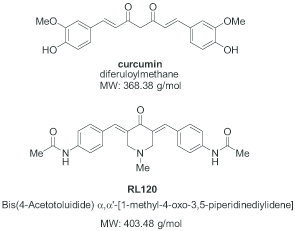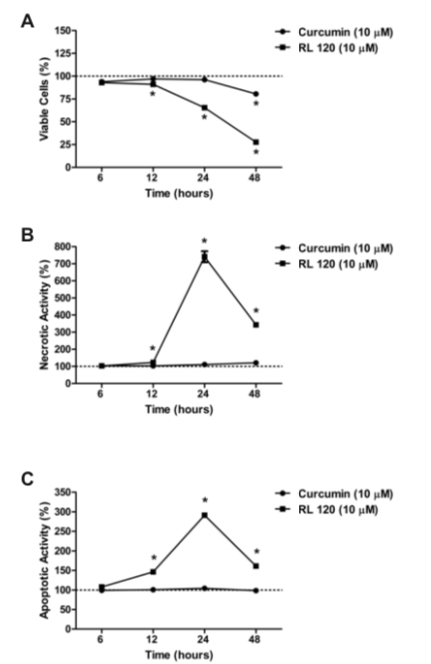IMPROVING MOTHER NATURE: ENHANCED ANTICANCER ACTIVITY DEMONSTRATED BY STRUCTURAL VARIANTS OF CURCUMIN
Bryant Megna*1, Patrick Carney3, Rhonda Rosengren4, Gregory D. Kennedy2
1Medicine, University of Minnesota Medical Center, Minneapolis, MN; 2University of Alabama at Birmingham School of Medicine, Birmingham, AL; 3University of Wisconsin School of Medicine and Public Health, Madison, WI; 4University of Otago, Otago, Otago, New Zealand
Background:The naturally occurring small molecule curcumin has long been shown to be a potent anti-inflammatory, chemopreventive, and chemotherapeutic agent. However, its low bioavailability, complex metabolism, and promiscuous binding targets limit its utility. We have synthesized a novel 2ndgeneration polycyclic curcumin analog, RL120 (3,5-bis(4-acetamidobenzylidene)-1-methylpiperidin-4-one). We hypothesize that this new small molecule will exhibit an enhanced antitumor profile in vitroagainst colorectal cancer compared to curcumin. Materials and Methods:The synthetic protocol for RL120 was designed and conducted at a single institution (Fig. 1).Curcumin was available commercially (Fig. 1). DLD1 (adenocarcinoma), HCT116 (carcinoma), and RKO (poorly differentiated carcinoma) cells were propagated in vitro. Cells were treated in logarithmic phase with either 10 μM curcumin, 10 μM RL120, or 0.05% v/v DMSO (vehicle) for 6, 12, 24, and 48 hours. In vitro assays assessing cell viability, cytotoxic necrosis, and apoptosis were performed. A polymerase chain reaction (PCR) array for both apoptosis and necrosis was used to assess death pathways induced by RL120 treatment. Statistical analyses were conducted on technical triplicates using the Wilcoxon rank sum and Jonckheere-Terpstra tests. P < 0.05 was considered significant. Results:We found a time-dependent decrease in cell viability induced by RL120 in all three cell lines (% viable cells remaining at 48 hours: DLD = 55% (p<0.001), HCT116 = 40% (p<0.001), RKO = 28% (P<0.001))(Fig. 2). Additionally, treatment with RL120 was 2.8x more potent than curcumin as measured by induction of apoptosis (p<0.001). Cytotoxic necrosis was increased significantly by RL120 treatment in both DLD1 (2.8x) and RKO (6.7x) cells vs. curcumin (p< 0.001) (Fig. 2). Further, using RNA expression arrays, we identified the novel target dihydropyrimidinase-related protein 4 (DPYSL4) as being upregulated 11-fold by RL120 treatment (P<0.05).
Conclusions:We have established that the novel 2ndgeneration curcumin derivative RL120 exhibits superior antitumor action against colorectal cancer compared to its natural parent compound in vitro. Further, we have identified dihydropyrimidinase-related protein 4 (DPYSL4) as a potential mediator of these effects. Current work focuses on characterizing these signaling events as well as determining if the agent will serve as a chemopreventive in vivo. Curcumin is in part made famous by its ability to target tumor cells and spare healthy colon mucosa. If proven to have a similar safety profile, coupled to its enhanced anticancer properties, RL120 represents an exciting candidate for continued study as a chemotherapeutic for colorectal neoplasia.

Back to 2020 Abstracts
